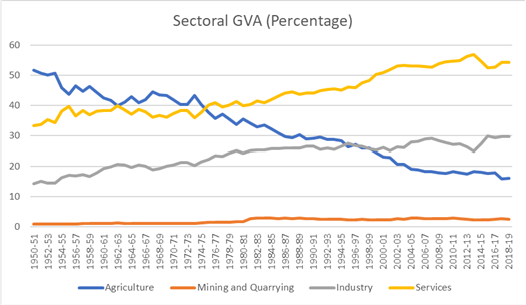Focus: GS-III Indian Economy
Introduction
The importance of services in the Indian economy has gone up over time. In 2004-05, services constituted 43.5% of the economy. By 2019-20, the proportion had jumped to more than 50%.
What is manufacturing sector’s share?
- The size of manufacturing sector has varied between 15%-16% of the economy in the last decade and a half.
- Generally, it has been noted from the histories of many, now developed, countries that at initial stages of development, primary sector was the most important sector of economic activity.
- People begin to use more goods that were produced in factories at cheap rates, the Secondary sector gradually becomes the most important in total production and employment.
- And then, a further shift from secondary to tertiary sector in developed countries is observed.
- While production in all the three sectors has increased, it has increased the most in the tertiary sector. As a result, the tertiary sector has emerged as the largest producing sector in India replacing the primary sector.

How do you explain growth of services?
- Building factories generates funds for upgrading them, which then increases pressure to invest in improving roads, bridges, ports, railroads, power grids, and water systems.
- All this creates jobs, which pay people and give them the purchasing power to demand services.
- With the manufacturing sector not creating enough jobs, people have had to fend for themselves to earn a living.
- This is reflected in the informal services sector, with the huge number of street vendors and small businesses seen across cities.
What other activities form part of services?
- Everything from trade, hotels, transport, financial services, real estate and public administration come under services.
- Ever since the imposition of covid-induced lockdown, most of these sectors have either been asked to remain shut or norms of social distancing have ensured that people are staying away.
Why is the revival of services important?
- Services form half of the economy. As the Report on Fifth Annual Employment-Unemployment Survey (2015-16) has pointed out: “67.5% of self-employed workers had average monthly earnings [of] up to ₹7,500.”
- Even four years later, things could not have improved much. Hence, the ability of the self-employed to survive is limited.
-Source: Livemint




